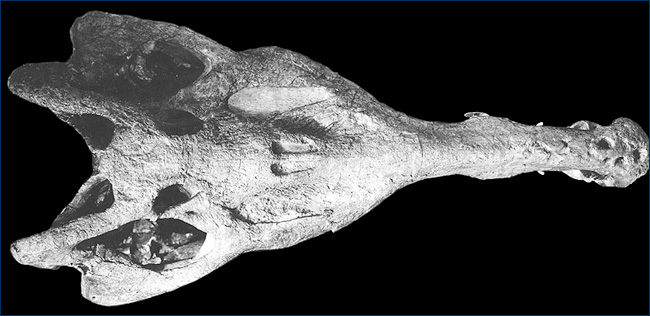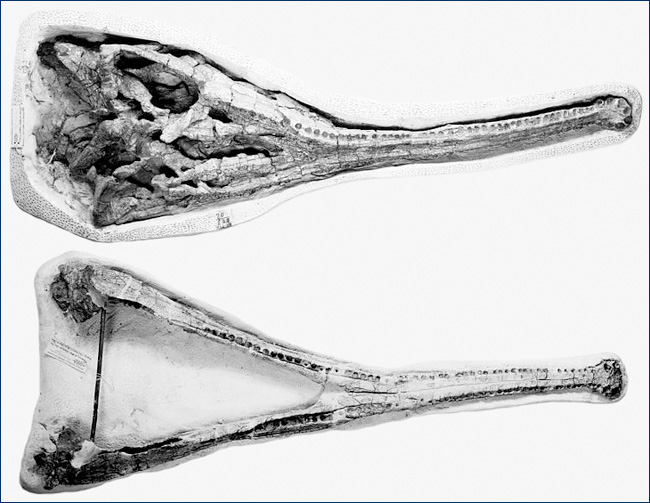
Phytosauria
The phytosaurs
Most pseudosuchians or "croc-line" archosaurs didn't look much like crocodiles, but phytosaurs were a definite exception. In fact, phytosaurs looked almost exactly like living crocs. They had short legs, wide, heavy bodies with rows of armored scales, long tails, and long toothy snouts. The only obvious difference between crocodiles and phytosaurs is that crocodiles have their nostrils at the ends of their snouts, and phytosaurs had them on raised hump in front of their eyes. Despite the strong similarities between phytosaurs and crocodiles, the two groups are not closely related. Phytosaurs are the most primitive group of pseudosuchians — even the plant-eating aetosaurs, sail-backed ctenosauriscids, and bipedal shuvosaurs were more closely related to crocodilians. The similarities between phytosaurs and crocs are the product of convergent evolution, in which two different lineages evolve similar features as they adapt to similar lifestyles.
The name phytosaur means "plant lizard." The first phytosaur fossil ever discovered was not very well preserved, and the scientist who found it thought that some mud casts of the tooth sockets were actually the teeth. Because these supposed teeth were blunt and rounded, he thought the animal must be a plant eater. Actually phytosaurs had sharp, cone-shaped teeth like crocodiles, and they ate fish and other animals.
Most of what we think we know about the habits of phytosaurs comes from living crocodilians. Among living crocs, the shape of the skull is roughly correlated with diet. Gavials have long, slender snouts and homodont teeth (all of their teeth look the same), and eat mostly fish. Alligators, caimans, and crocodiles have short, broad snouts and heterodont (differently-shaped) teeth — big pointed teeth for stabbing, small pointed teeth for gripping, and blunt, rounded teeth for crushing — and they eat larger and tougher prey, including land animals, turtles, and shellfish.
Phytosaur species show a similar division of skull shapes, with some having very long, slender snouts and homodont teeth, and others having broader snouts and more heterodont teeth. Presumably the narrow-snouted species ate mostly fish and broad-snouted species ate a wider variety of prey. Phytosaur skeletons have been found with the remains of other reptiles in their stomachs, including terrestrial animals like rhynchosaurs (stocky, pig-like herbivores). Phytosaurs may have ambushed land animals when they came down to rivers or water holes to drink, just as living crocodilians attack antelopes and deer. At 12 meters long, the largest phytosaurs were as large or larger than the biggest living crocs, and they were the largest predators of the Triassic Period outside of the ocean-going ichthyosaurs.
 A skull of Smilosuchus adamanensis (specimen no. 26699) collected from the Late Triassic Chinle Formation in 1921, Apache County, AZ, by a UCMP party. |
Many rock formations have fossil remains of two phytosaur species, one narrow-snouted and one broad-snouted. For example, the narrow-snouted Redondasaurus gregorii and the broad-snouted Redondasaurus bermani are found in the American Southwest, and the narrow-snouted Mystriosuchus planirostris and the broad-snouted Mystriosuchus westphali are found in Germany. The strange thing is that these pairs of species seem to be each other's closest relatives. The two species of Redondasaurus are more closely related to each other than to any other phytosaurs, and the same is true for the two species of Mystriosuchus — even though the shapes of the jaws and teeth suggest that narrow- and broad-snouted species ate different prey. It is tempting to wonder if each pair of species might really be the male and female forms of a single species. However, the species in each pair differ in other ways that have nothing to do with the shape of the skull, and they are not always found together in the same deposits. It is more likely that in each region the ancestral phytosaurs specialized in eating different things, and they eventually diverged into two closely related species. The same thing happened with Darwin's finches in the Galapagos. It is still remarkable that this evolutionary pattern was repeated so often and so precisely in phytosaurs.
All known phytosaurs are from Upper Triassic rocks. An animal called Mesorhinosuchus was described as a primitive phytosaur from the Lower Triassic of Germany. It had characters intermediate between early archosauriforms and later phytosaurs. Unfortunately, the only fossils of Mesorhinosuchus were from Germany and were destroyed during World War II. Furthermore, the rocks that Mesorhinosuchus was found in are probably not from the Lower Triassic after all. So the origin of phytosaurs remains somewhat mysterious. No existing fossils show the evolution of phytosaurs from earlier archosaurs. Paleontologists suspect that they have not yet discovered a missing record of phytosaurs from the Middle Triassic. Another group of pseudosuchians, the rauisuchians, have been found in Middle Triassic rocks, so the phytosaur ghost lineage must go back that far as well.
 The skull and mandibles of Pseudopalatus pristinus (specimen no. 34245) collected from the Late Triassic Chinle Formation in 1933, Rio Arriba County, NM, by UCMP's Charles Camp et al. |
The Upper Triassic lasted from 228.7-199.6 million years ago. Within those 28 million years, four distinct groups of phytosaurs are found, one after another through time. Because phytosaurs are widespread and abundant, and because the four groups do not overlap, paleontologists can use them to tell geologic time. By identifying the phytosaurs in a given quarry, paleontologists can tell what part of the Upper Triassic the bones in the quarry are from.
Phytosaurs apparently went extinct at the end of the Triassic, and in the Lower Jurassic their place was taken by early crocodyliforms like Calsoyasuchus. Calsoyasuchus had a long narrow snout and it is one of the first crocodyliforms that pursued a semi-aquatic lifestyle like modern crocs (other early croc relatives were terrestrial predators). It seems that crocodyliforms only moved into the water after the phytosaurs went extinct.
Phytosaurs have been found in North America, Europe, Asia, northern Africa, and Madagascar, but not in South America, sub-Saharan Africa, Australia, or Antarctica.
Sources
|
||
Text by Matt Wedel, 5/2007; Smilosuchus and Pseudopalatus photos from the UCMP archives